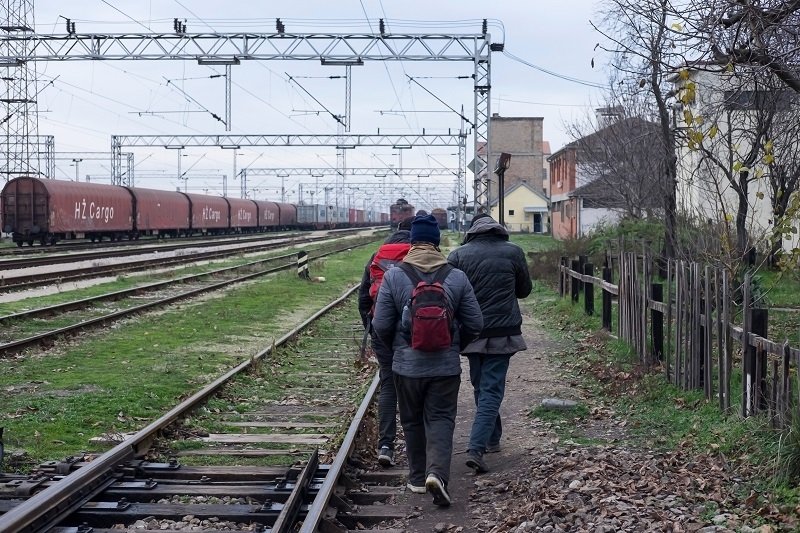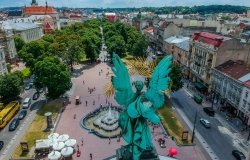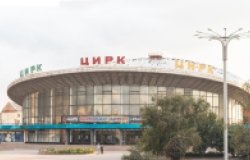
A blog of the Kennan Institute
Losing Brains and Brawn: Outmigration from Ukraine

BY DENYS KIRYUKHIN
Until a few years ago, the steady increase in outmigration from Ukraine and the subsequent loss of labor and intellectual capital were not at the forefront of the country’s concerns. Today the situation has changed: politicians and state authorities have injected a note of urgency in discussions of migration. It is telling that nearly all the presidential candidates in the recent elections raised the issues of labor migration and emigration almost as frequently as they did issues of corruption and the armed conflict in the Donbas.
This heightened concern owes to the emerging, and now seemingly unavoidable, threats to Ukraine’s economic and demographic situation posed by the outflow of workers and intellectual resources. The situation is so severe that migration expert Franck Düvell of Oxford University has called Ukraine “Europe’s Mexico,” in reference to comparable levels of migration from and through both countries. A fenestrated labor force and the loss of intellectual resources as students train abroad for jobs in the EU have placed iron shackles on Ukraine’s prospects for future development.
Aleksandr Turchinov, head of the National Security and Defense Council of Ukraine, has characterized the population movement as a “migration tsunami.” According to his estimates, up to 9 million Ukrainians out of a total population of 42 million annually work abroad for some part of the year, and 3.2 million have regular full-time work outside the country; of these, most do not plan to return. However, Ukraine would not have experienced such a daunting loss of labor and intellectual resources had the military crisis in Ukraine’s East and its economic fallout not coincided with the growing need of the Visegrád Four countries—the Czech Republic, Hungary, Poland, and Slovakia—for a labor force to help develop their economies. Thus both push and pull factors are at work: the conflict with Russia acts to drive migration, while changes in the migration policies of Ukraine’s neighbors have opened their labor markets to Ukrainians. Broadly speaking, this two-pronged mechanism accounts for the mass outmigration of Ukrainians since 2014.
The main beneficiaries of this situation are Ukraine’s neighbors, chiefly Poland and Russia. In February 2018, the influential Polish publication Gazeta Prawna published a list of people who, according to the experts consulted, had had the greatest impact on the Polish economy in 2017. In second place, between Prime Minister Mateusz Morawiecki and President Andrzej Duda, were Ukrainians—“the collective hero of the Polish economy,” in the language of the article’s authors. Such a dominant position was arrived at in large part through Ukrainians filling the labor force gaps created by Poles emigrating to Western Europe to work, which scaled up after the country's accession to the EU. The influx of workers from Ukraine turned out to be a real salvation for the Polish economy, and the Polish authorities in turn have actively supported this labor migration by relaxing certain legal requirements.
An indication of the strength of the Ukrainian penetration of Poland’s workforce is the more than 1,700,000 work declarations issued to Ukrainian citizens in Poland in 2017, almost eight times the number issued in 2013, just five years earlier. Although the pace has slowed somewhat, social conditions, such as strong migrant workers’ networks and the low cost of living in Poland, which allows larger remittances to be sent home, are other advantages that help solidify an ongoing Ukrainian presence in Poland’s workforce.
Though Russia still receives a considerable population of migrant workers from Ukraine, the number has dropped substantially following Russian actions in Ukraine. Compared with 2013, when Ukrainians received 161,200 permits to work in Russia, in 2015 only 94,700 permits were issued (data from the Federal Migration Service of Russia). This figure does not reflect all Ukrainians working in Russia, since a significant portion work without permits, but even the official figures are very revealing.
The downward trend in labor migration to Russia appears to be solidly based in pragmatism rather than ideology. According to polls conducted in late 2017, 63.2 percent of respondents (adults aged eighteen or older) justified the practice of earning in Russia, in a situation in which Ukraine has officially recognized Russia as an aggressor country. Better opportunities for migrant workers in other countries, particularly Poland, which pays a higher average salary than Russia does, have attracted Ukrainian workers and may be largely responsible for the sharp decline in labor migration to Russia.
At the same time, the Visegrád Four countries do not yet have a single coherent migration policy. For example, a feature of the Hungarian migration policy includes support for the immigration of ethnic Hungarians into the country. In line with that, Budapest supports the acquisition of Hungarian citizenship by Ukrainian Hungarians. Nevertheless, ethnic Hungarians cannot alone satisfy the needs of the growing Hungarian economy, especially because about 9 percent of the working-age Hungarian population words abroad.
This leaves the Hungarian authorities in an extremely difficult situation. Yielding to nationalist sentiment, Viktor Orban’s government approved legislation restricting the influx of migrants into the country (primarily aimed at migrants from the Middle East), thereby undermining European solidarity in solving the refugee crisis. At the same time, it has developed legislative measures that give employers the right to require staff to work up to 400 hours in overtime per year (the so-called “slave law”), which caused mass protests in the country. Looking ahead, it’s likely that the Hungarian authorities will ease immigration laws for migrants from Ukraine instead of opening borders for Middle Eastern and North African refugees.
As for the Visegrád Four’s other countries, Poland and Slovakia are generally interested in attracting foreign workers and students, while the Czech Republic, like Germany, wants a highly skilled labor force. Changes in Germany’s migration policy that make it easier for employers to hire foreign workers and Hungary’s growing need for workers suggest that in the future, there will be competition for the Ukrainian labor force between Germany and Poland on the one hand, and among the Visegrád Four countries on the other.
Finally, brains follow brawn. The educational migration has followed the main direction of labor migration since 2014. The number of Ukrainian students studying in Poland, Russia, Slovakia, and the Czech Republic significantly increased after 2014. These are also the countries receiving the main flows of labor migration.
Ukrainians who go abroad to study often view their studies as the first stage of emigration. A survey of Ukrainian students at universities in Poland, Hungary, and the Czech Republic showed that students who studied in these countries had similar motives for doing so. Most said they intended to earn a diploma in order to work in the EU in the future, since living conditions in Ukraine were unsatisfactory; few planned to return home after graduating. Those who do return may be the ones unable to settle abroad in permanent positions. The negative selection of young specialists—brain drain—is an unwanted consequence of the economic situation currently obtaining in Ukraine. With top-tier intellectual and labor resources leaving the country more or less permanently, Ukraine faces an uphill battle in developing its economy.
The economic consequences of outmigration are mixed. In the short term, the export of labor resources is profitable for Ukraine. It reduces social tensions in the country and makes a significant contribution to the country's budget (in 2017, private transfers from abroad amounted to U.S. $9.3 billion, four times greater than the amount of foreign direct investment and accounting for approximately 4 percent of Ukraine's GDP). The favorable budgetary bump, among other factors, has allowed Ukrainian authorities to close their eyes to the threats posed by the labor and brain drain. In the long run, however, outmigration, especially if it continues at the current pace, will severely hamper the country’s economic development. Ukraine will be in the same situation in which Poland found itself several years ago, when economic development became virtually impossible without attracting foreign labor. But, unlike Warsaw, Kyiv has limited resources to attract labor. This means that Ukraine will not be able to solve the problem simply by opening its labor market to migrants.
The Ukrainian government has not yet proposed a satisfactory solution to this acute problem and has not taken any steps to minimize the existing threats. As Minister of Foreign Affairs of Ukraine Pavel Klimkin observed in February 2018, about 100,000 people were leaving Ukraine every month. Nothing has mitigated the outflow since then.
About the Author

Denys Kiryukhin

Kennan Institute
The Kennan Institute is the premier US center for advanced research on Russia and Eurasia and the oldest and largest regional program at the Woodrow Wilson International Center for Scholars. The Kennan Institute is committed to improving American understanding of Russia, Ukraine, Central Asia, the Caucasus, and the surrounding region though research and exchange. Read more










